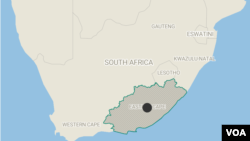South Africans living in the East Cape count down to "Day Zero" when the faucets in the Nelson Mandelabay area are depleted. According to experts, the drought caused by climate change has almost emptied the reservoir, but due to a mismanagement of the local government, city officials are scrambling to block more than 3,000 leaking water pipes. increase.
Five Virginia Kima 68-year-old grandmas live in Kwanobre, a poor town in the area named after Nelson Mandela Bay, South Africa's largest hero and first black president.
But she said her recent life has been difficult.
"Sometimes we stay for about a couple of days without water," she said. "When I don't have water, I go elsewhere to get water."
Kima tells VOA that the faucet dries and walks 25 minutes to school to fill her bottle. increase.
The Gulf region suffers from a serious water shortage. Officials said the area's dam water storage is about 11% of its capacity and could be further exacerbated.
At current utilization, the two major reservoirs could disappear completely in a few days. In that case, 40% of the city of Gqeberha, which has a population of about 1 million, will be affected.
Luvuyo Bangazi, a spokesman for the government committee dealing with the shortage, told VOA that authorities are competing to prevent "Day Zero" when water is scarce.
"As for the exact date of DayZero, there are so many moving parts that you can't include such a date in your calendar," he said. "We are doing everything we can to prevent the faucet from running out."
Mr. Bangaji said there are several reasons for low water levels, both natural and artificial. Said.
"It hasn't been raining for more than seven years. Water consumption from various sectors, whether residential, business or other sectors, is skyrocketing," he said. "So it combines it with an apparently sick infrastructure that leads to serious leaks ... Almost 25-30% of our water is lost due to leaks caused by infrastructure failures. "
More than 3,000 leaks have been reported to city officials, and the team states that they are scrambling to fix them.
Mr. Bangaji said the community also needs to reduce water consumption. This is 60 million liters per day more than the size of the population, he says.

Meanwhile, authorities have set up a communal water station and aid workers are drilling holes for wells.
Mary Galvin, associate professor of development research at the University of Johannesburg, said water shortages indicate an urgent need to combat climate change.
"Reaching zero is an example and expression of a climate crisis that stays here. It's hot, and meteorological events such as droughts and floods are intensifying, so this is us. It's yet another sign that we see all over the country, in Africa, and around the world. "
Galvin pointed out that South Africa also has problems with water inequality.
Wealthy residents of Nelson Mandela Bay can dig their holes and buy storage tanks, but poor people here like Grandma Kima have to walk to find water. not.
The water shortage in Nelson Mandela Bay occurs just a few years after Cape Town, South Africa's major tourist city, slightly avoids its own Day Zero.


